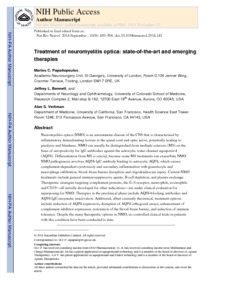Papadopoulos, MC; Bennett, JL; Verkman, AS
(2014)
Treatment of neuromyelitis optica: state-of-the-art and emerging therapies.
Nat Rev Neurol, 10 (9).
pp. 493-506.
ISSN 1759-4766
https://doi.org/10.1038/nrneurol.2014.141
SGUL Authors: Papadopoulos, Marios
![[img]](https://openaccess.sgul.ac.uk/107694/7.hassmallThumbnailVersion/nihms637974.pdf)  Preview |
|
PDF
Accepted Version
Available under License ["licenses_description_publisher" not defined].
Download (1MB)
| Preview
|
Abstract
Neuromyelitis optica (NMO) is an autoimmune disease of the CNS that is characterized by inflammatory demyelinating lesions in the spinal cord and optic nerve, potentially leading to paralysis and blindness. NMO can usually be distinguished from multiple sclerosis (MS) on the basis of seropositivity for IgG antibodies against the astrocytic water channel aquaporin-4 (AQP4). Differentiation from MS is crucial, because some MS treatments can exacerbate NMO. NMO pathogenesis involves AQP4-IgG antibody binding to astrocytic AQP4, which causes complement-dependent cytotoxicity and secondary inflammation with granulocyte and macrophage infiltration, blood-brain barrier disruption and oligodendrocyte injury. Current NMO treatments include general immunosuppressive agents, B-cell depletion, and plasma exchange. Therapeutic strategies targeting complement proteins, the IL-6 receptor, neutrophils, eosinophils and CD19--all initially developed for other indications--are under clinical evaluation for repurposing for NMO. Therapies in the preclinical phase include AQP4-blocking antibodies and AQP4-IgG enzymatic inactivation. Additional, albeit currently theoretical, treatment options include reduction of AQP4 expression, disruption of AQP4 orthogonal arrays, enhancement of complement inhibitor expression, restoration of the blood-brain barrier, and induction of immune tolerance. Despite the many therapeutic options in NMO, no controlled clinical trials in patients with this condition have been conducted to date.
Statistics
Item downloaded times since 21 Sep 2018.
Actions (login required)
 |
Edit Item |



